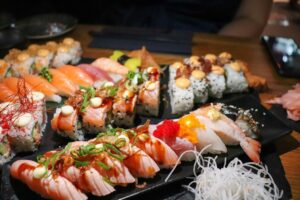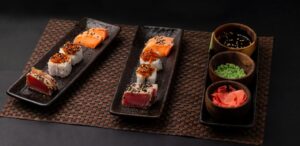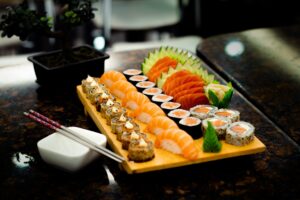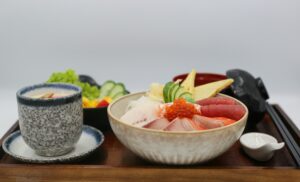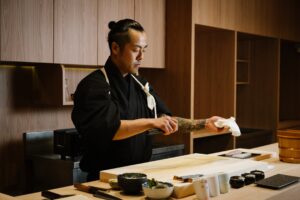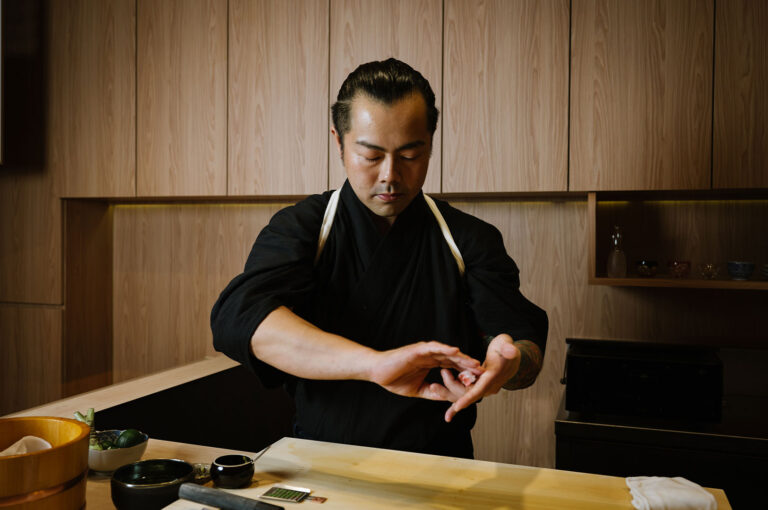
Best Food in Singapore: A Japanese Chef’s Guide to the Lion City’s Culinary Paradise
After twenty years perfecting the art of sushi and studying Japanese cuisine across the finest establishments from Tokyo to Singapore, I’ve witnessed countless diners struggle to identify what truly makes the best Japanese restaurant. The difference between good and exceptional Japanese food lies not just in taste, but in the intricate details that most guests never see—the daily sourcing from Toyosu Market, the precise temperature of sushi rice, and the decades of training behind every knife cut.
As the Head Chef at Sushi Masa by Kisetsu—an intimate, eight-seat omakase counter—I’ve dedicated my career to understanding these nuances. This comprehensive guide will reveal the essential elements that distinguish exceptional Japanese restaurants from the ordinary, helping you navigate the diverse landscape of Japanese dining with the discernment of a seasoned professional.
What Makes the Best Japanese Restaurant: Essential Elements
The foundation of any exceptional Japanese restaurant begins long before the first diner arrives.

Premium Ingredients Sourced Daily
- Premium ingredients sourced daily from Japan’s Toyosu Market represent the gold standard, ensuring that each dish reflects the peak quality that Japanese cuisine demands. At Sushi Masa, we maintain direct relationships with suppliers who transport fish within 24 hours of catch, preserving the delicate flavors that define authentic Japanese food. Our menu is an uncompromising expression of the sea and the seasons.We specialize in the meticulous art of omakase, where the focus is strictly on premium seafood and fish. We ensure the integrity of every course, from the finest cuts of tuna and salmon for sashimi and nigiri to the authentic flavor of our meticulously prepared Japanese rice.
In line with the traditional pursuit of Washoku, we highlight seasonal ingredients—including delicate vegetable accents—to achieve an elevated dining experience where every dish reflects the purest, freshest flavor available on that very day.
Skilled Chefs and Traditional Techniques
- Years of apprenticeship under master chefs—often a decade or more—develop the intuitive understanding necessary to handle premium ingredients with proper respect. This training encompasses the philosophical approach: precision, seasonality, and harmony. Some chefs also incorporate French techniques, blending classical methods with Japanese cuisine to elevate each dish.
Authentic Preparation Methods
- Genuine establishments maintain techniques passed down through generations, from the proper aging of fish using traditional jukusei methods to the careful preparation of shari (sushi rice) with precisely balanced vinegar blends. Dishes are served immediately after preparation to ensure optimal freshness and quality.
Attention to Seasonal Ingredients (Shun)
- Exceptional restaurants adjust their selections based on what reaches optimal flavor at each moment, ensuring menus reflect nature’s peak offerings. This commitment requires extensive knowledge and flexible planning. The use of seasonal produce helps achieve a perfect balance of flavors in every dish.
The Preparation of Sushi Rice (Shari)
Perfect shari is maintained at body temperature, possessing the appropriate stickiness and balanced seasoning that complements, rather than overwhelms, the fish. This fundamental element is a critical differentiator.
Clean, Minimalist Ambiance (Ma)
Ambience reflecting Japanese aesthetic principles creates the proper atmosphere. The best Japanese restaurants embrace ma—purposeful use of space—creating environments that enhance, not distract from, the culinary experience. Unique restaurant features, such as traditional decor and specialized furnishings, further enhance the Japanese dining experience. Some establishments also offer a private dining room for guests seeking exclusivity and privacy, adding to the overall sense of luxury and intimacy.
Omotenashi Hospitality
This traditional approach anticipates needs without intrusion, ensuring a seamless experience. Staff are trained to provide genuine care for diner comfort and satisfaction.

Types of Premium Japanese Restaurants in Singapore Worth Visiting
Understanding the diverse categories helps diners choose experiences that match their preferences and expectations, especially within Singapore’s vibrant scene. The landscape of premium Japanese dining encompasses specialized establishments that focus on particular aspects of Japanese food culture. Whether you are searching for a renowned Japanese restaurant in Singapore or looking to explore Singapore’s top culinary destinations, the city offers a remarkable variety of options known for their quality and authenticity.
Singapore offers an impressive array of Japanese dining experiences. Marina Bay Sands stands out as a premier location, housing renowned restaurants. Chinatown Point is another popular dining hub, featuring multiple Japanese food outlets and convenient access for both locals and tourists. Cuppage Plaza also serves as a key destination, home to hidden gems and intimate counter-style experiences. These destinations showcase the best that Singapore offers for Japanese cuisine, from omakase to sushi and more.
Edomae Sushi Restaurants - The Pinnacle of Best Japanese Food
Edomae sushi restaurants represent the highest expression of sushi artistry, often featuring traditional counter seating with high-quality materials like hinoki cypress wood. These intimate settings allow for direct interaction between chef and diner, creating personalized experiences that showcase the chef’s skill.
At premium spots like Sushi Masa by Kisetsu, the price tag for a chef-curated omakase isn’t just a charge for food; it’s an investment that covers the sheer cost of those exceptional, daily-sourced ingredients and the decades of skill behind the chef’s precise knife work.
Sushi is served with freshly grated wasabi for authenticity, enhancing the traditional experience. Some sushi pieces are topped with luxurious ingredients such as caviar or truffle paste, adding a modern and upscale twist. A variety of toppings are available, elevating both the flavor and presentation of each piece. This style maintains focus on proper sushi rice, which is often aged and seasoned with red vinegar to create the authentic flavor profile that distinguishes traditional Edomae from modern interpretations.
The delicious sushi served here ensures a memorable dining experience. Limited seating arrangements, such as Sushi Masa’s eight-seat counter, ensure personalized attention and maintain quality standards that larger establishments cannot match.
Kaiseki and Fine Dining Japanese Restaurants
Multi-course seasonal menus reflecting Japanese culinary philosophy characterize Kaiseki establishments, where each dish represents a meditation on ingredients, technique, and aesthetic presentation.
For those seeking an exclusive experience, the chef’s table offers a luxurious, private setting where diners can witness world-class culinary craftsmanship up close. These restaurants elevate Japanese food to high art.
Emphasis on presentation, seasonality, and harmony in each dish creates dining experiences that transcend mere consumption, often featuring an element of surprise in the chef’s selection that contributes to an unforgettable meal. The multi-course menu typically concludes with a refined dessert, highlighting the chef’s attention to every detail.
Specialty Japanese Restaurants
Beyond the main fine dining pillars, specialty restaurants demonstrate mastery of specific preparations. This includes Unagi specialists, who use binchotan charcoal grilling, or Tempura masters, who employ sesame oil and precise temperature control to achieve light, crispy textures. Yakiniku restaurants are also prominent, focusing on premium meat cuts and traditional Japanese grilling techniques that highlight the quality and flavor of each selection.
Authenticity can also be found in Ramen shops featuring 12-hour tonkotsu broths and house-made, springy noodles that deliver the perfect chewy bite. Diners are encouraged to eat at these specialty establishments to experience the unique flavors and craftsmanship firsthand.
Meanwhile, some establishments combine traditional techniques with a creative twist, offering striking presentation and atmosphere, and featuring a broad menu of sushi, robata, and creative plates in a dramatic setting, often accommodating both business and special celebrations.
Key Factors When Choosing the Best Japanese Restaurant
The pursuit of the best Japanese restaurant ultimately comes down to understanding and appreciating the dedication to craftsmanship and cultural authenticity.
Ingredient sourcing and freshness serve as the foundation, with daily shipments from Japan preferred for maintaining optimal quality. Restaurants that compromise here rarely achieve the authentic flavor profiles. Chef credentials and training background in Japan provide essential context; chefs who have completed traditional apprenticeships under recognized masters bring knowledge that significantly contributes to the excellence of their preparations.

The restaurant atmosphere and adherence to Japanese design principles create environments that support the dining experience, with attention paid to how ambiance affects the perception of subtle flavors. Service quality reflecting traditional Omotenashi hospitality ensures that technical excellence in the kitchen translates to a truly memorable experience.
When deciding where to dine, it is important to check the restaurant’s opening hours, as some establishments operate only on specific days such as Mon-Fri or Mon-Tue. Consider whether you are planning to visit for lunch or dinner, as many Japanese restaurants offer special lunch sets or dinner menus, often with a minimum spend required for certain promotions. Set meals frequently include soup, which is a hallmark of a balanced and authentic Japanese dining experience.
The Chef's Secret Code: What Sushi Masa Looks For
For those of us who have dedicated years to the craft of Japanese cuisine, the quality of an establishment isn’t hidden in the menu prices; it’s revealed in a handful of seemingly small, yet critically important, details. These signs are the secret code that separates a merely good sushi meal from an experience of genuine, masterful artistry.
The Uncompromising Details of Excellence
It’s the subtle acts of discipline that truly matter, revealing a chef’s commitment that goes beyond the counter.
The very first test is the wasabi. If you see a chef using a tube of pre-made paste, that is a red flag. Fresh wasabi grated tableside immediately signals a restaurant’s commitment to authenticity. Real wasabi delivers a nuanced flavor and bright, fleeting heat that artificial substitutes simply cannot replicate, making this detail a direct indicator of uncompromising standards.
Next, you must feel the shari—the sushi rice. The rice is the soul of the dish, and its temperature is critical. Proper sushi rice temperature, maintained at body temperature with the appropriate texture and seasoning, demonstrates the chef’s technical competence. Rice that’s too cold or improperly seasoned betrays shortcuts that compromise the entire sushi experience, regardless of how pristine the fish is.
A serious establishment never serves a static menu. Seasonal menu changes reflecting ingredient availability show that the chef prioritizes quality over convenience. This is the principle of shun: adapting offerings to showcase ingredients at their peak. This necessary flexibility requires deep knowledge and advanced supply chain management that characterizes only the most dedicated restaurants.
Discipline Beyond the Counter
The standards of quality extend into every corner of the operation.
Look for transparency, especially in open kitchen concepts. Clean, organized workspaces visible to diners provide a layer of honesty that confident chefs welcome. The best Japanese restaurants maintain spotless work areas and precise organization, a discipline that reflects the respect for ingredients and process demanded by this cuisine.
The chef’s hands are the most important tools. Appropriate knife skills and precise fish-cutting techniques reveal the depth of a chef’s training. Proper cutting enhances, rather than diminishes, the ingredient’s quality, affecting both texture and flavor. A true master chef knows how to adjust their technique for every unique species and cut of fish.
Finally, the experience is completed by the beverage service. Correct sake serving temperatures and glassware selection demonstrate a comprehensive understanding of Japanese dining culture that extends beyond the food. The best Japanese restaurants treat sake with the same respect as they do the fish, ensuring that the vessel and the temperature enhance the spirit, elevating the entire meal.
Making Reservations and Dining Etiquette
Advanced booking requirements for premium establishments typically extend 2-4 weeks for popular time slots, with some exclusive restaurants maintaining longer waiting periods for first-time diners. The best Japanese restaurants often require confirmation 24-48 hours prior to service due to specialized ingredient preparation.

Proper etiquette for a sushi counter or Omakase experience centers on respect and trust in the chef’s expertise. Guests should follow the chef’s recommended pace and order of service, consuming each piece promptly to appreciate its intended flavor profile while avoiding excessive application of soy sauce or wasabi. For Omakase, the most crucial protocol is to communicate all dietary restrictions and preferences before the meal begins, allowing the chef to curate a cohesive, tailored experience. This respectful, anticipatory approach is key to enjoying the specialized artistry of the sushi counter.
Sake pairing elevates Japanese dining when selections are made to properly complement food flavors and the meal’s progression. The finest Japanese restaurants employ sake specialists (kikisake-shi) who guide guests based on personal preferences and food pairings, often using tasting flights to showcase different regional styles and complexity levels. This professional guidance ensures a harmonious experience. Traditional sake customs further enhance authenticity: guests should always accept a pour from a companion (never self-pour), use the appropriate glassware for the sake style (e.g., small cups for delicate ginjo, or masu boxes for ceremony), and recognize the social aspect of shared consumption as an essential cultural protocol.
Tipping practices in Japanese restaurants vary by location and service style, with many traditional establishments incorporating service charges or operating under no-tipping policies that reflect Japanese hospitality customs. Understanding local practices prevents awkward situations and ensures appropriate appreciation for exceptional service.
The Essence of Exceptional Japanese Dining
The pursuit of the best Japanese restaurant ultimately comes down to understanding and appreciating the dedication to craftsmanship, seasonal awareness, and cultural authenticity that defines exceptional Japanese dining. Whether seeking the intimacy of a premium sushi bar, the artistry of kaiseki, or the comfort of authentic ramen, discerning diners can find extraordinary experiences by recognizing the quality indicators and cultural principles that guide truly exceptional establishments.
At Sushi Masa, we invite you to experience our interpretation of these timeless principles, where daily sourcing from Toyosu Market, traditional preparation techniques, and genuine omotenashi hospitality combine to create unforgettable meals that honor the profound traditions of Japanese cuisine while serving the sophisticated palates of modern Singapore.

